In the following email marketing for affiliates guide, you will learn what email marketing is and, most importantly, how to use email marketing to generate affiliate sales and increase your commissions.
Before anything else, you should never forget that your audience isn’t waiting for your emails– you are likely interrupting them. That’s why you need to offer a compelling reason for them to give you 10 seconds to read it and then do an auction (visit a website, purchase a product, etc.).
Briefly, email marketing is an aspect of direct marketing used mainly to promote your products or services. You send emails to build relationships with your subscribers and leads by providing them relevant and helpful advice to help them take action and go a step closer to achieving their goals.
There are plenty of solid reasons you should start email marketing to generate affiliate sales.
Table of Contents
1. Six Reasons for starting an email list today
When you build an email list, you can get more people to subscribe to receive your emails.
The more ways you offer your visitors to subscribe to your Email, the bigger your email list will be.
You should know from the beginning that your email list will become one of the essential ingredients of your affiliate marketing blogging success.
So here are the reasons why you should start with list building from the very beginning:
1.1 Promote new or newly updated content
With an email list, you can drive a flood of traffic to new (or freshly updated) pieces of affiliate content.
Let’s pretend you have an affiliate blog about the best running shoes.
You just published a shiny new guide reviewing a brand new item from Nike.
Without an email list, that page sits there until you start ranking for your targeted keywords on Google or paying for PPC ads on Google and Facebook. You might get some traffic to the page from visitors who click links from your other pages, but it’ll take a while before you start driving enough traffic to generate revenue from it.
With an email list, you can drive hundreds to thousands of visitors to the page as soon as you publish it for every new article you write. That makes producing new affiliate content more profitable since you can see immediate profits from your promoting product.
Not only that, but it’s like having your dedicated outreach database. Instead of cold emailing a bunch of people to check it out and hope they share it, you can send it to thousands of people who have already asked to receive it with a single broadcast email. That results in an immediate boost of traffic to the page, feedback, social shares, links, mentions, and most importantly, sales.
The same goes for your old pieces of content. For example, let’s say you wrote an article last year about the 50 best running shoes of 2021.
In 2022, you can re-update that article, add a bunch of new shoes to it (with brand new affiliate links), and blast it out to your email list. Again, immediate profits you can realize much faster than if you were just to publish and wait for it to rank.
The point is, that you have the control to send a lot of traffic to the pages you want. And that’s an exciting thing to have for an online business.
1.2 Direct traffic to your most profitable pages
Let’s start with the one that directly affects your affiliate sales.
If you’re collecting emails, you can create autoresponders. Whenever someone subscribes, they receive a series of pre-written emails. I do this using ConvertKit.
Why is that good?
Because within these emails, you’re able to direct more people to the pages you want them to see, maximizing traffic to your highest converting affiliate pages. You’re adding another traffic source for your more profitable pages instead of relying on Google.
But wait. Wouldn’t trying to collect email addresses distract users from clicking on affiliate links?
No. You can optimize your opt-in forms according to your site’s primary objectives. So if your goal is to get the maximum amount of people to click on your affiliate links, simply don’t show any forms during this stage.
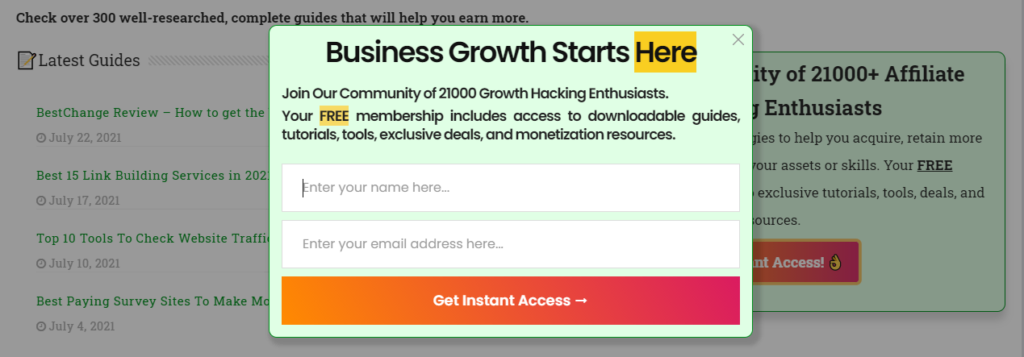
You can use ConvertKit or OptinMonster (exclusive discount here) to build exit-intent popups only to show an opt-in form when the reader is about to hit the back button. Exit-intent popups convert exceptionally well.
1.3. Email Helps You To Make A Connection With Your Audience
Building an email list is vital because it’s the best way to build a connection with your audience in a personal way. People will subscribe to your email list because they like the things you share.
When you send them emails, they will be thrilled because they like you and trust you enough that they want to see more of what you have to offer.
1.4 Run special affiliate product launches
If a company you’re promoting runs any special promotion, an email list allows you to take advantage of that and use it for a launch.
For example, if Nike decides to run a huge sale one week for their Fall collection, you can treat that as a chance to do a big launch to your email list.
You can use their sales deadline as your scarcity factor and run a full-blown launch campaign.
1.4.1 Partner with companies to run exclusive promotions
If your email list becomes large enough, you can get companies to partner with you and run launches for their new products or any deals they’re offering. This is a little more work, and many affiliate sites never get large enough to make this work, but it can be done if you build up a sizeable audience.
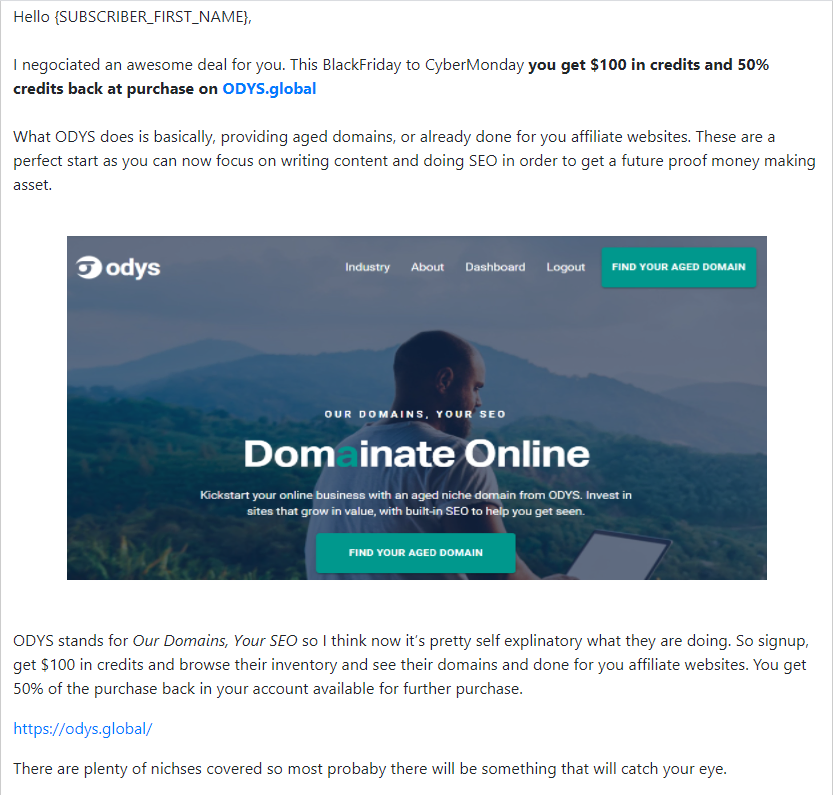
1.4.2 You can run your product launches
Want to add another income stream to your affiliate site?
Creating your product can be a very profitable option. I’ve seen this first hand for my content sites.
Revenue earned per product sale will usually be multiple times higher than a 5% affiliate commission, so it can quickly outgrow your affiliate revenue, especially if you’re using evergreen sales funnels.
1.5. Email Is An Effective Way To Grow Your Social Media Channels
Your audience is probably not following you on all your social media accounts, and Email is a great way to tell them about the places you share your content.
Make sure you grow your social media accounts while growing your email list. Don’t forget to invite your followers on social media and join your email list.
When you are just starting with email marketing, you don’t have the set-up to grow your email list. Even if that sounds discouraging, don’t worry because you can set up everything you need in one hour.
1.6 An email list increases your site’s valuation
Apart from the fact that it gets valued higher due to higher monthly revenue, an email list is a bonus for selling your site.
An email list is an asset on its own, and as you learned, many options become available to you when you have grown a large subscriber base.
Including an email list of thousands of people can make it more attractive to buyers and increase your site’s valuation since you’re adding another asset to it.
One of my recent sites was listed for sale with a list of nearly 10,000 people, and it received a valuation of over 30x monthly revenue.
2. How to build an email list for affiliate marketing
With around 300 billion emails sent each day, there’s a lot of competition for your audience’s attention. That’s why it’s essential to learn the correct email marketing method, so you can catch up with your target audience and hold their attention.
2.1 Sign Up With an Email Service Provider
First, you will want to sign up with an email service provider.
Email service providers will help you capture new subscribers, create awesome emails and newsletters, organize your subscribers, segment them, and provide all the statistics you need after sending an email.
I recommend the email provider, especially for beginners, is HubSpot’s free email marketing tool. It enables you to create, personalize, and optimize marketing emails that look professional. There is a combination of features to help you build the best email marketing campaigns.
My top two recommendations for advanced users are Activecampaign and Convertkit. I ran my business on MailChimp, then moved to Aweber, CoverKit, Drip, Infusionsoft, and ActiveCampaign. From all of that, these two suggested options stand out for different reasons.
Some top-rated email service providers are on my shortlist, and Drip is a solid platform and seems to fit somewhere between CovertKit and ActiveCampaign. It has great automation and an excellent email builder, but where ConvertKit and ActiveCampaign stand out in their respective areas, Drip didn’t amaze me. And Infusionsoft, for a pretty long time, has been the standard for automation. I used it for a while and then found that even simple automation requires a whole complex bunch of tags to set up, but managing and changing these things can become an absolute nightmare.
So as I said, my top two recommendations for email service providers are ConvertKit and ActiveCampaign.
2.2 Create Your Opt-in Form
An opt-in is a form of permission given by your visitors to contact them with additional information.
Opt-in forms allow you to grow your subscriber list by collecting email addresses. They can be presented as popup forms on the homepage or landing pages and built-in widgets across your website.
How to create a form with HubSpot’s form builder:
- To create a form, first, you should log into your HubSpot account and click on Marketing > Lead Capture > Forms.
- Now click Create form.
- In the left panel, select Regular form.
- Then click Next.
- Select would you start with a blank form or a pre-made template?
- After selecting the template, click Start.
- Click the pencil icon at the top of the form editor to edit the form name.
- To edit and add form fields, use the search bar to search for a field.
- Now drag and drop fields onto the form preview on the right to add them to your form. Fields can be placed above, below, or next to other fields.
- To customize your form options, click the Options tab.
- Now set what should happen after a visitor submits your form. You can choose to display a thank you message to your visitors or redirect them to another page.
- Then you can click on the Style and preview tab to choose a theme for fields and buttons and customize the form’s width, fonts, and colors.
- When you choose a theme, fonts, and colors, click Publish to make your form live so you can embed it on your website.
If this looks complicated and you just want a simple form, you can check Hello Bar and Sumo.
2.3 Hello Bar
Hello, Bar is a WordPress plugin that you can use to add a notification bar at the top of your WordPress blog and some other popups to help you engage with your visitors. These notification bars help boost conversion, drive traffic to a particular page, or increase affiliate sales.
Hello, Bar is a decent lead generation tool and offers a free plan. Setting it up is very easy.
- Type your domain name in the homepage text box to create an account.
- After creating an account, you can choose from the different types of Hello Bar. If you’re using it to collect emails, you’ll want to choose to show an announcement or collect Email.
- Then fill in the information for the bar, like color and message.
- Use the Next button to continue through the five main steps or click the left menu tabs.
When you click Save and publish, you can choose the installation option. Install the code yourself or install the Hello Bar plugin to make it easier.
2.4 Create Your Content Upgrade
You have to create a content upgrade that will add more value to your content and convert the visitors into subscribers. Those visitors will give you their email addresses in exchange for the free content upgrade.
Content upgrades are specific and targeted. Because of that, they can improve your conversion rates while increasing your chances of making the sale. A visitor who downloads your content upgrade is very interested in what you are talking about, and it’s more likely that he will follow your affiliate link.
Open your best blog posts on your website and think about what you can create to add more value to that particular piece of content. Ask yourself what problem is the reader encountering. What information does it cover?
When you have a few ideas, create them.
It’s not nuclear physics and won’t take more than an hour or two per content upgrade.
Here’s a list of content upgrades you can create easily:
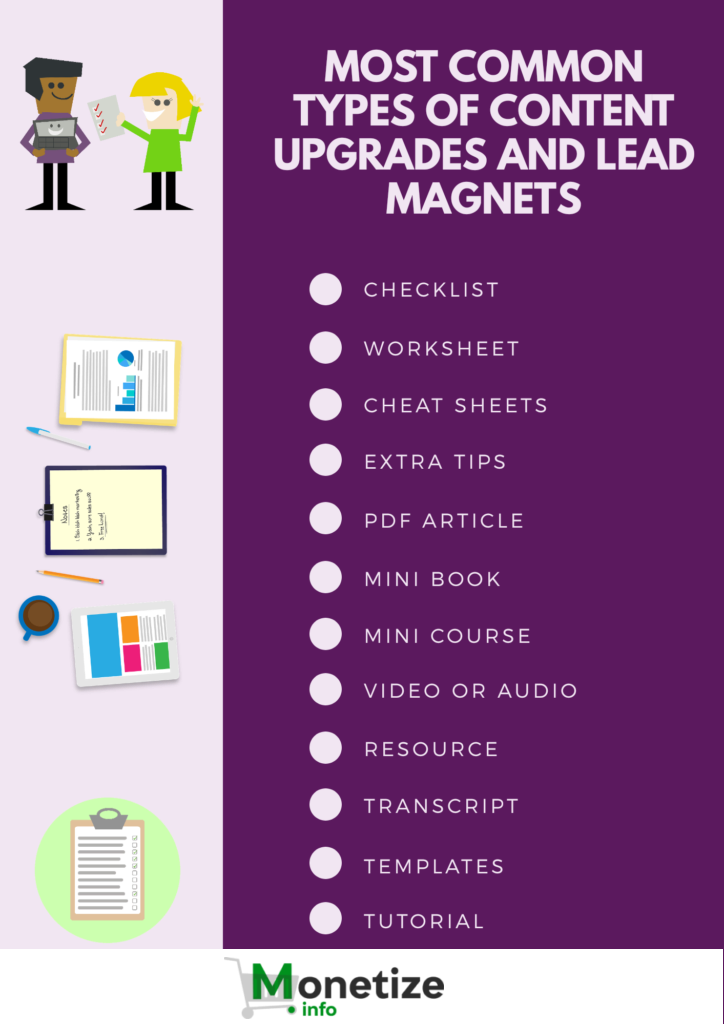
When you know what you want to offer and create it, you have to insert the content upgrade into the content and offer it to your visitors.
2.5 Create Your Lead Magnet
In the previous paragraph, I explained your content’s conversion rate optimization. But you’ll want your whole website to be optimized. So now, I’ll show you how to optimize the site-wide conversion rate.
That means you’re going to try that more of the traffic that visits your site, sign up for your email list. You’ll do this by creating a lead magnet.
A lead magnet is practically the same as a content upgrade, but it’s not specific. You can create checklists, PDF articles, challenges, or blueprints. You can choose to offer whatever you want but keep in mind that it has to be made for the bigger part of your target audience.
So, content upgrades are tied for the specific blog post and lead magnets for your website’s general theme.
As I already said, you won’t do good if you just ask for emails. Instead of just asking for emails, you offer something in exchange for their emails. That’s why you need to create a site-wide opt-in offer.
It can be simple. Just offer something and set up your email apps just like you did for the content upgrade.
You can increase your site conversion rate by giving your visitors more chances to subscribe.
For example, let’s say you are using Sumo, so you have the Welcome Mat and add an exit-intent popup. So visitors who weren’t ready to subscribe with a welcome mat get another opportunity to subscribe when they leave your website. This way, you can collect emails you wouldn’t collect otherwise.
How does it sound to you? Not bad, right?
Remember, if you distract visitors with too many things to do when they visit your page, they probably won’t do anything at all. Remove distractions and only keep what is necessary on your page.
So far, you’ve discovered how to set up email technology and how to set up your website and content to collect emails. Now it’s time to write a couple of emails you’ll send to your new subscribers through autoresponder on an automated schedule.
2.6 Create a Landing Page
A landing page is a page that is specifically designed to get and convert traffic from your online marketing campaign. I recommend using an affiliate marketing theme with high converting landing page templates.
Here are a couple of must-haves for every landing page:
- It should have one precise goal, and every part of it needs to be designed to move viewers toward that goal.
- You have to make sure that your landing page is compatible with your topic and optimized for mobile devices and speed.
- Your headings on a landing page need to be attention-grabbing, and all distractions must be removed.
- Always use a Call To Action, limit the amount of information you ask your visitors, and make sure you use great visuals.
3. Writing Your First Emails
It’s best to write a couple of emails simultaneously and save them to your autoresponder. Otherwise, you’ll have to constantly think about creating content for your emails.
Just focus on creating several valuable emails to keep your subscribers engaged for a couple of hours.
Do you think you can do this?
I bet you can. It doesn’t have to be complicated. Just do it.
Types Of Emails You Can Send To Your Subscribers
You can choose some of these ten different types of emails. Start with the Welcome Email, and go down the list until you create at least 4.
3.1 Welcome Email
A welcome email is your chance to tell your subscribers more about you, your website, and how they can benefit from it. You must start to build a connection with them immediately after subscribing.
Don’t forget to include a call to action of what you want your subscribers to do next, like following you on social media. Take advantage of the momentum while they are still interested in what you are offering.
Remember, they have to get this Email right after subscribing.
3.2. Expectation Email
You should include when you’ll send emails, how often you’ll send them, and what you’ll send them in this Email.
You should also include a call to action to whitelist your email address. This will tell your email service provider that your emails are not spam.
You can include this into a welcome email if you want or send it separately a day after your welcome email.
3.3. Resources Email
This Email should include a list of free and paid tools you use (make sure you have your affiliate links) to help your audience get the desired results.
Send it at the beginning of the sequence while they are still engaged.
3.4. Inquiring Email
With this Email, you invite them to tell you about their challenges around your topic. In the end, let them know that you will read every response you get. This can help to achieve maximum engagement from your subscribers.
They will tell you precisely what to write about in your future emails to please them.
Asking your audience about issues they’re experiencing will help you create content and give you insight into exactly what your audience wants. You can use their exact words for your sales copy, content, and emails.
Send it within the first couple of weeks.
3.5. Informative Email
In this Email, you ask them to respond to you with information about themselves. As an affiliate marketer, you want to know as much as you can about your subscribers. The more information you get from them, the more targeted your marketing can be, achieving more sales.
It should be different from inquiring Email, don’t ask for their issues with your topic. Ask them about their lives and experience with your topic in general.
Send this one within the first two or three weeks.
3.6. Free Gift Email
Every once in a while, send your subscribers a gift. It can be a worksheet, a video, or a tool to help them. You have to surprise them from time to time and remind them that subscribing to your list was a good choice they made.
Send it often if you can.
3.7. Exclusive Content Email
Sending out emails with exclusive content to your subscribers is a great way to reward them for being on your list. It helps build loyalty.
You don’t have to complicate here; you can give them exclusive content in a shorter form, like a couple of quick tips. Just give them something that can not be found on your website.
Send them maybe once a month. The more exclusive and valuable content you give to your subscribers, they’ll be more interested in what you have to say.
3.8. Content Email
Content teasers are an incredible way to get your subscribers back to your website because they can excite them about a post you’ve published. So every time you publish new content, send a content email to notify subscribers about it.
There is another, more straightforward way to do similar things. It’s called RSS to Email. I prefer content teasers because people will come back to your website, and with RSS to Email, you automatically send the whole post into subscribers’ inbox, so they don’t need to visit your site.
Send them every time you publish something new.
3.9. Recommendation Email
You share other people’s content in this Email, so you don’t have to create it yourself. For example, you can tell them about ten articles you enjoyed so they can read them too.
You can send them regularly or anytime you need a break.
3.10. Newsletter Email
Newsletters are regular updates about your site. Send them when you have updates to share with your subscribers.
Best of all, after creating these 10, you can repeat 8 of them for a continual follow-up sequence.
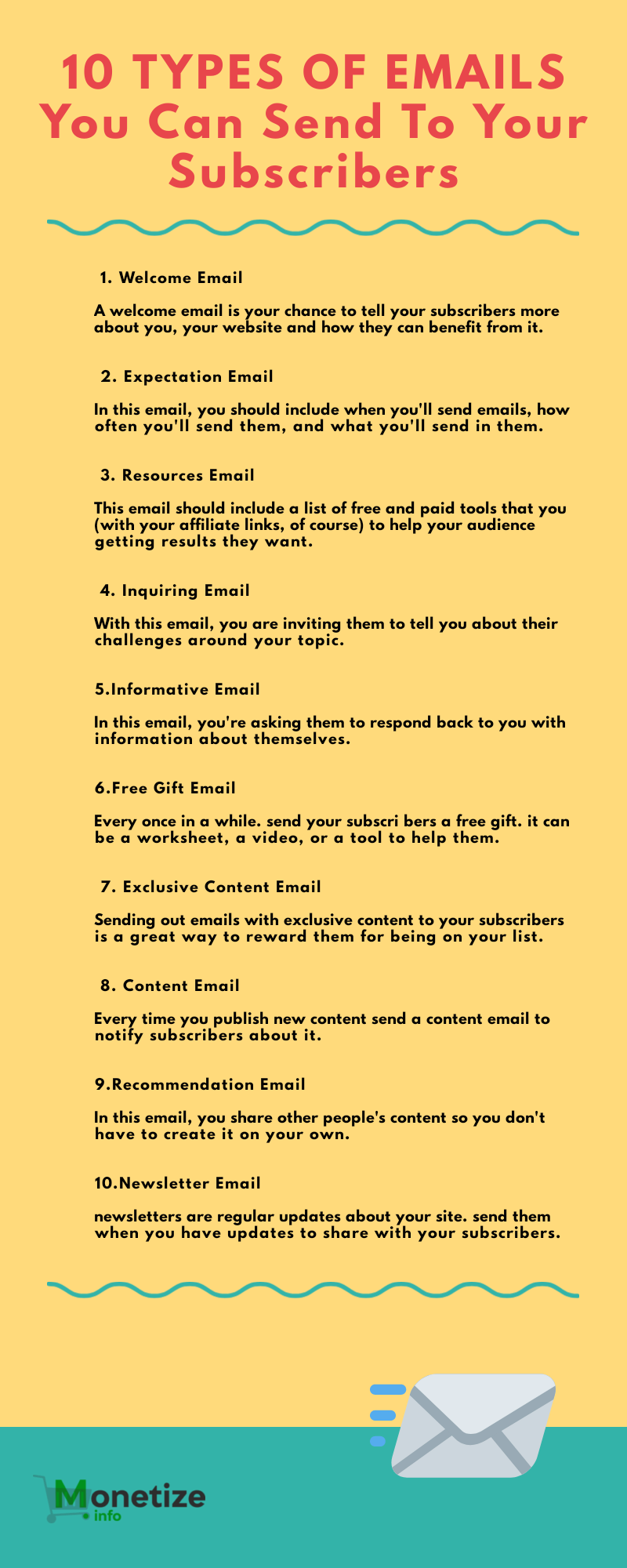
4. The Best Time To Send An Email Campaign
If you have no idea how to schedule your emails, here’s a quick guide.
You should send the first emails faster, as you are getting your new subscriber introduced to you. Then, you need to back off for a couple of days. You don’t have to follow that exact format, but don’t email every day. If you send too often, that can increase your email unsubscribe rates.
4.1 When to send your emails
According to these researches, you can try to send emails in this order:
- Tuesday: The best day to send emails, according to the data from this research.
- Thursday: If you send two emails a week, send 2nd Email on Thursday.
- Wednesday: Research showed that Wednesday wasn’t the most popular but often came in second place.
When it comes to the time of the day, many of the researches shown differing results; here is when you can try to send your emails based on data:
- 10 a.m.-11 a.m. Late-morning times were the most popular in general; many research types determined this was the best time to send emails.
- 8 p.m.-midnight They found out that emails normally get more opens and clicks later in the evening. Do you check your emails before going to bed?
- 2 p.m. Try to send your emails later in the day as people look for work distractions.
- 6 a.m. Lots of us begin our day by checking emails and notifications while still in bed. You can try to send it at this time, but I believe we are not ready for marketing early in the morning.
4.2 Find The Best Time To Send Emails By Looking At Your Audience
You can use data from Google Analytics to discover the best time to send your emails. You can get significantly higher click-through rates if you send at the right time.
The first method I’m about to show you demands the Google Analytics mobile application, so you don’t already have Google Analytics on your mobile smartphone. You can download it for free.
The first thing to do is go to the menu and click on Behavior; right under Behavior is Overview. Click on it, and you scroll down to the bottom, and you will find a graph that looks similar to this.
It shows sessions by the time of day. This technique is based on when people are most likely to be on your site. The best time to send the emails is based on the spread of how the blue is distributed. Light blue means the least number of visited pages, and as you get to the darker blue, it means that more page views are going on around that time. Look for that dark blue spot and test it.
The second method is based on your email referrals and works only if you have email referrals. If you are just starting with email marketing, you should use the 1st method.
When you open your analytics report, set the start date and end date, then select Email.
You filtered your data to show only referral traffic from Emails, and you’ll see the best days that give you the most traffic from emails. From there, you can click through again to see the best times by hour when you receive that traffic.
4.3 Takeaways
With this information, you are one step closer to getting more benefits from email marketing.
Here’s a summary of the process:
- There is no universal best time for everyone.
- Test the best days and times to find out when your audience is most active with Google Analytics reports.
- Send your emails on Tuesdays.
- Send emails at 10 a.m.
We are all creatures of habit that subconsciously want consistency. So send your emails on the same day every month, week, or day. By being consistent, you build trust and expectation as your audience expects your content at a designated time.
5. Email Marketing Segmentation
Email marketing segmentation divides your email subscribers into smaller lists based on different criteria. With Segmentation, you have the ability to send only the most relevant information to your email subscribers based on their particular interests.
You realize that not everybody will be interested in everything you write about, so every website has different audience categories (or segments).
Let’s say, for example, that you have a fitness blog. Some of your readers might want to lose weight, and others want to gain muscles. Those are some segments of that audience.
Your audience has segments, too. Think of the larger categories that could fit your audience. When you’ve recognized these categories, set up segments related to those categories in your email service provider. Surveys and quizzes work wonders when it comes to Segmentation.
After doing this, you can connect your content upgrades to different segments.
Segmentation is an important part of email marketing. Believe me, once your list grows, you’ll be glad you do Segmentation and have an organized email list. Without email marketing segmentation, connecting with your subscribers and boosting your conversion rate is challenging.
6. Email Marketing KPIs
How do you know that your campaign efforts are paying off, and most importantly, what can you do to get the desired results?
Through KPIs of email marketing!
KPIs or performance indicators are like “your on-board computer,” which shows you moving in the right direction or away from it.
We’ll show you 9 KPIs for email marketing that you should monitor in your campaigns by the end of this article.
One thing to keep in mind: in this article, we will not address the average values (benchmarks) for these indicators because they vary depending on the niche, the stage in the funnel, etc.
Okay, let’s go.
6.1. Open Email Rate
This is the percentage of subscribers who open an email sent by you.
Email Open Rate FAQ
How do you calculate the email open rate?
Opening rate = (no. Emails open / no emails sent) x 100
Do not worry! Email marketing platforms provide you with this indicator (and the next ones we will talk about) without manually calculating it every time.
How do you improve the open Rate?
✅ Personalize the sender’s name
Instead of naming the company, try a more personal version, such as “Stephan from Monetize.info” instead of “Monetize.info.” People tend to respond better to people than to impersonal companies.
✅ Segment your list and use a relevant copy for each segment
It is an essential email marketing activity that often gets little attention. Yes, sending the same newsletter to the entire subscriber list is more convenient. However, people will not open the Email unless they consider it relevant. A generic approach leads them to conclude, “It’s not for me / I’m not interested.”
Segmentation criteria include:
- geographical location
- age / sex
- buying behavior: added to cart vs. customers on first order vs. customers with two or more orders
- categories of products purchased
- degree of involvement: subscribers who have opened the last five emails vs. subscribers who have not opened the previous five emails
Our recommendation: segment your list according to the criteria relevant to your business and adapt the communication (both in the title and in the body of the Email) according to the respective list segment. If the Segmentation is well done, it becomes much easier to test various title or text variants for your message.
You will see increases in the opening and click-through rates, especially conversion rates.
✅ Update your list
The opening Rate of your emails decreases even more, when there are contacts in the list that no longer interact with messages received for more than a few months. They have lost interest, no longer using the address, or are no longer part of your target audience.
That’s why once every 4-6 months, it makes sense to clean up the list and remove contacts that are no longer relevant. This way, you also save money on your monthly email marketing platform subscription. You no longer have to pay extra for contacts that no longer interact with you at all.
However, before doing the subscriber filtering action, run an activation campaign. In short, you are updating why you should stay on the list and make a special offer (win back). Also, instead of sending a single reactivation email once, allow a time-out for this campaign to resend contacts who didn’t open it for the first time or test a few new titles or submission times.
Note: Make sure you follow the GDPR rules in this process.
Then delete the contacts that no longer react and segment the remaining contacts.
✅ Timing matters
According to a study by Campaign Monitor, the best days of the week are Tuesday, Wednesday, and Thursday, and the best time would be between 9-11 am.
But it is not a general rule. We also had cases where the opening rate was better around the afternoon.
So, test several hours and days a week to see exactly which of them has the best email opening rate.
✅ Persevere
This means sending the Email again but only to those who did not open it. This way, you will have the opportunity to test another day, another hour, and increase your opening rate considerably.
6.2. Click-through Rate
It is one of the essential email marketing KPIs. This is the percentage of subscribers who click on one or more of the links in an email you sent.
Click-through rate FAQ
How do you calculate the click-through rate?
Click-through rate = (total number of clicks or single clicks/number of emails delivered) x 100
Ex: You sent an email that reached 5,000 subscribers. In total, you had 50 clicks on the email link. Clickthrough rate = 50/5000 x 100 = 1%
The click-through rate shows a higher and more explicit interest in your content/products than the opening rate.
How do you improve the click-through rate?
✅ Set a clear goal for your message
Too many calls to action (CTAs) can confuse the potential customer or force them to choose only what is convenient for them (and not necessarily suitable for you).
So, test with a single call to action (CTA). There are cases where this is not possible. For example, send a newsletter structured in several sections (let’s say you have 5-6 links in total). In this situation, it would be preferable to prioritize the essential links in the first part of the message and observe / test which links bring better results.
The call to action must also be clear and convincing. Avoid the clickbait that misleads the reader and delivers something other than what you initially promised. If you lose the reader’s trust, you may receive the initial click, but you will see lower click (and conversion) rates.
✅ Delivers an excellent reading experience
This involves several activities:
- creates “airy” emails that are easy to scan, without large blocks of text that seem hard to read
- use short or at most medium-length sentences
- make the message very easy and enjoyable to read on your mobile
- uses well-sized images that look great on both mobile and desktop
✅ Segment & Customize
Segmentation is one of the essential email marketing strategies. Your subscribers will be more inclined to click if you’ve done the proper Segmentation and customized the message for that list segment.
When we say personalization, we don’t just mean using tags like #[FNAME]# or #[LNAME]# (you can test to see results with or without them). Instead, we insist on creating a message to make the customer feel they are being addressed. Use direct rather than impersonal addressing and follow the tone of your brand’s voice.
✅ Copywriting, copywriting, copywriting
Email is an excellent way to apply copywriting techniques. However, they must be used in context, considering the interests and specifics of the list of subscribers.
Some useful suggestions:
- Tests various emotional triggers: Emergency, Rarity, Reciprocity, etc
- Creates the slippery “slope” effect
- Conversion rate
- ROI
- Bounce Rate
- Unsubscribe rates, in conjunction with spam complaints
- List Growth Rate
- Commitment (Social Shares + replies + forwards)
- Deliverability rate
6.3. Conversion Rate
As the name suggests, the conversion rate is the percentage of subscribers who clicked on one or more email links and completed the desired action (e.g., filling out a form or purchasing a product/service). This is one of the most common email marketing KPIs marketers and entrepreneurs look for.
Email Campaigns Conversion Rate FAQ
How is the conversion rate calculated?
Conversion rate = (total number of subscribers who completed the action / total number of delivered emails) * 100
Ex: 500 people who bought your product / 10,000 emails sent * 100 = 5% conversion rate for your campaign.
Unlike the opening and click-through rates, the conversion rate is an email marketing KPIs that most marketers or business owners look at. In other words, it is the metric that can tell the difference between a successful campaign and a less successful one in terms of results.
How to improve your conversion rate?
✅ Conveys emotion through the benefits of the product/service
I have noticed in the market, especially among entrepreneurs, that sometimes they emphasize the features of the product/service and not on its benefits.
After all, you’re not just selling the product, you’re selling the solution, the experience, and the excitement of your product or service.
Include in the title or even in the body of the Email the solution/emotion that your product or service conveys. Make things as personal as possible, so the customer will resonate more with what you sell and take action.
✅ Segment your subscriber list
Have you heard the phrase “The right man at the right time”?
We would say, “The right email for the right people.”
You can create the best Email with the best title and the best CTA, but if your Email doesn’t reach the right audience, the whole effort was in vain.
Subscriber segmentation is one of the essential things you need to increase your conversion rate.
When I talk about Segmentation, I mean dividing them into different categories.
For example, you can segment according to the number of purchases, the average value per basket, or the buying behavior in a specific time interval (1-3 months, 3-6 months, etc.).
In other words, the more you segment your subscriber list and the more specific your message is to each segment, the higher the conversion rate.
✅ Test, test, test
There is no recipe for success or a perfect plan that works every time.
It is essential to test as much as possible, from changing different title variations to changing the graphic elements (banners, pictures) in the body of the Email or even the message itself.
Only then will you be able to figure out what works best for you and your audience.
6.4. ROI (Return on investment)
The ROI is the percentage obtained from division no. of the total sales obtained following a campaign. Total investment.
Email campaigns ROI FAQs
How to calculate the ROI of your email campaign?
ROI = [(total campaign sales – initial campaign sales) / amount invested in the campaign] * 100
Here is a simple example: 1,000 euros total sales from the campaign – 100 euros initial sales from the campaign / 100 euros the amount invested in the campaign * 100 = 900% ROI from the campaign
How valuable is this KPI?
Well, from my point of view, by calculating the ROI, you can find out if E-mail Marketing works (generates sales) for your department or company.
How do you improve it?
✅ Segmentation is sacred
As with the conversion rate, Segmentation of the subscriber list is crucial.
Think of it this way: Let’s say you’re alone on a desert island and you have only one way to save – sending a single rescue message. What are you doing? Do you send empty by a simple SOS?
Or are you sending a targeted message to someone you know who knows they’re coming to save you?
That’s the way it is with Segmentation – Stop sending specific messages to the entire subscriber list, hoping someone will buy. Segment your list according to the Behavior and details of the subscriber (active, inactive, demographic details, etc.), so you can think of the message as specific as possible.
✅ Optimize mobile content
Today, more than half of all emails are open and read from your phone.
Most of us are on the move, on the way to work or home, and the fastest way to communicate is with a simple cell phone.
So, optimize the text and the graphic part of the Email to be easily read on your mobile.
✅ Includes Videos
Wistia did a test that included videos in the thumbnail, leading to a 22% increase in click-through rate = higher ROI.
They noticed that people were more tempted to press the play button than to look at a simple image.
This further confirms that information is “consumed” quickly, and people have less and less patience.
6.5. Bounce Rate
Bounce rate is another KPI for email marketing that you need to pay attention to. This is represented by the percentage of email addresses where our message was not delivered due to email providers (e.g., Yahoo, Gmail, etc.)
The bounce rate is divided into two categories:
- Soft Bounce – These are usually emails that “return” due to situations such as attachment too large or the recipient’s inbox being full.
- Hard Bounce – Represents invalid emails (domain name is incorrect or does not exist)
Bounce rate FAQs
How is the bounce rate calculated?
The calculation is straightforward – The total number of emails bounced / The total number of emails sent.
How Do You Reduce Your Bounce Rate?
✅ Check and keep the subscriber list clean
The chances are that the old addresses you have registered have not been active for some time.
Try to visually check for invalid email addresses and remove them from your list, so you’ll keep a fresh and active list of subscribers.
✅ Avoid SPAM emails
A global study shows that approximately 45% of emails sent are SPAM.
What does this mean?
Well, it seems that almost half of the emails we receive contain promotional messages like – “BUY NOW,” “Make money fast and secure,” etc.
I recommend that you avoid such messages in your text as much as possible, at least in the title area, so you risk your Email getting directly into SPAM.
✅ SHOW UP!
I know it may sound cliché but send regular email campaigns. Get as close as possible to your audience.
What do I mean by that? It’s getting to the point where your subscribers are waiting and anticipating your messages. If you keep your subscriber list active, your emails will go straight to where they need to be – in the inbox.
Of course, this requires patience, creativity, and consistency.
6.6 Conclusion on email marketing KPIs
In conclusion, we recommend checking and analyzing each email marketing KPIs for your email campaigns. They will help you follow the process closely to develop new ideas or tactics where appropriate.
7. Fast List Building Techniques
At this point, we set everything up, and now you can continue creating content and content upgrades and wait a couple of months before you start getting significant traffic from Google.
Or you can try some of the most effective, fast list-building techniques available to grow your list quickly and see the power of email marketing.
7.1 Give Something Away
Giveaways are one of the best strategies to drive visitors to your site and grow your email list.
You have to select something valuable to give away to your audience. Something that is specific to them and what they will want to have. Then promote the giveaway on giveaway submission sites, social media, and your website and make it necessary to sign up for your email list to enter the giveaway.
You can use the RafflePress plugin for WordPress to get your visitor’s attention with giveaways. They’ll have to enter their email address to participate, and they can share it to earn additional entries.
7.2 Create Cornerstone Content
Cornerstone articles are long, informational articles that integrate knowledge from different blog posts and cover everything necessary about a specific topic. They should provide the best and most complete information, so don’t use them to sell products.
Cornerstone content is viral in that it’s so good that your readers cannot help but share it. That’s why it needs to be detailed. If you just scratch your topic, nobody is going to share it.
All your other posts about related topics should link to the cornerstone article. This internal linking structure will increase the chance of your cornerstone content articles ranking in Google searches.
After you’ve created the content, you should also create a content upgrade. Cornerstone content with a content upgrade can be your most valuable list-building tool.
7.3 Write a Guest Post
The difference between cornerstone content and guest post is instead of writing a fantastic piece of content for your own site, you write it for your competition.
You are looking for blogs with content related to your niche and an engaged audience interested in your niche. By engaged, I mean that posts have been shared and commented.
As for your cornerstone content should also create a content upgrade that the audience can’t resist and link to it in your bio if the host site allows that.
Guest posting is a great strategy to grow your email list to do email marketing, connect with other blog owners, and build backlinks and social proof.
Conclusion
Let’s summarize:
- Get an email service provider and an email capture tool
- Create content upgrades, lead magnets, and landing pages
- Write at least 4 emails and add them to the autoresponder
- Don’t forget about Segmentation
- Use giveaways, cornerstone content with content upgrades, and guest posting to rapidly grow your email list and get your email marketing onto a higher level.
That’s it. I hope you have more knowledge about email marketing, and now it’s up to you how you’re going to use it.
Studies show that email marketing still beats other digital marketing channels like social media and paid search. Email marketing is the best long-term investment with a high return, and one of the biggest mistakes you can make is not to build an email list from the start.
Email lists can significantly influence traffic and your opportunities for success with your online business.
 Monetize.info We Help You Grow & Monetize Your Online Business!
Monetize.info We Help You Grow & Monetize Your Online Business!

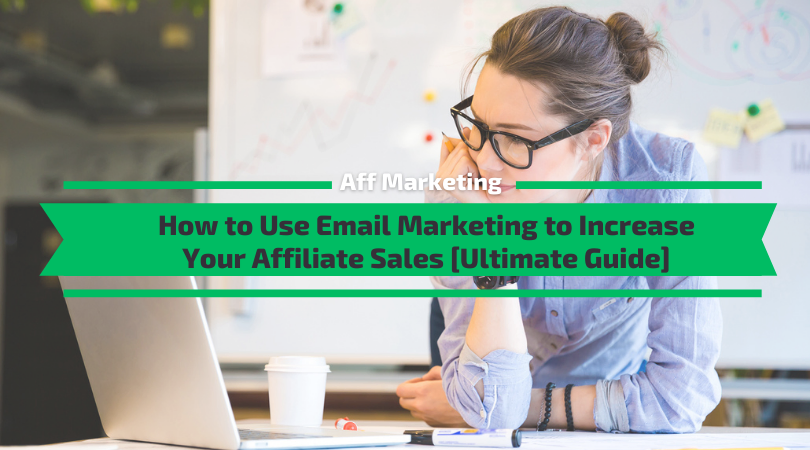
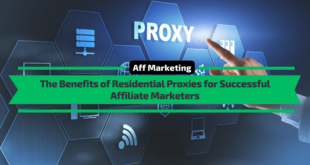
![Is an Affiliate Program Right for Your Online Business? [PROs & CONs, Examples]](https://monetize.info/wp-content/uploads/2024/07/Is-an-Affiliate-Program-Right-for-Your-Online-Business-310x165.webp)
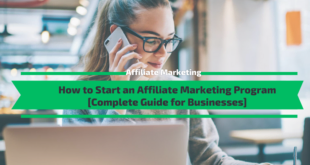
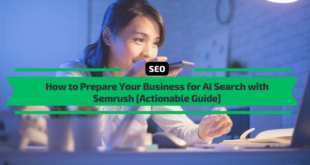
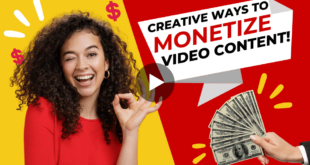
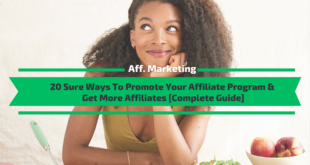
It is very gainful information. Thanks for share it.